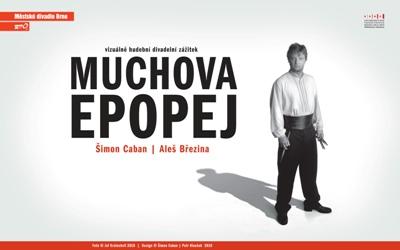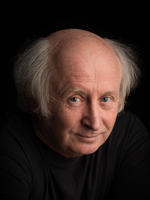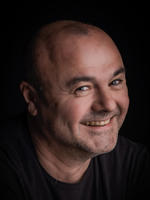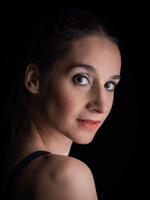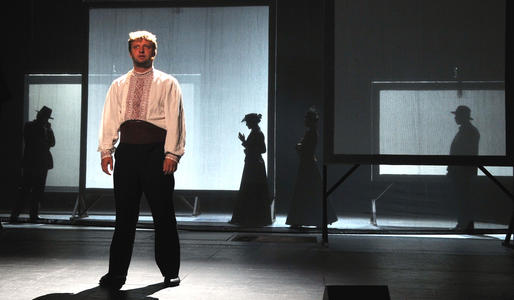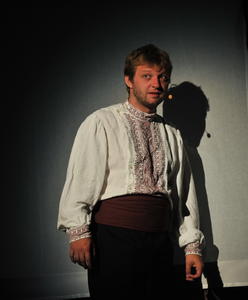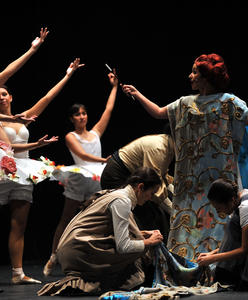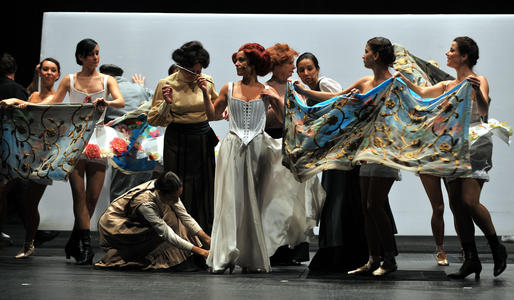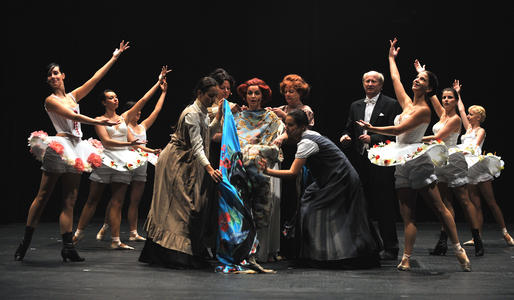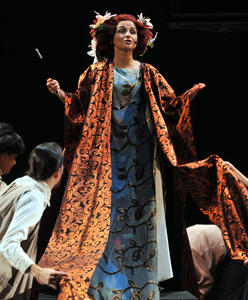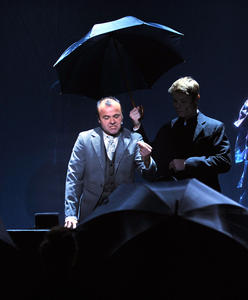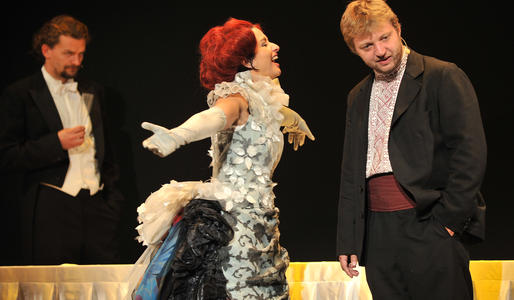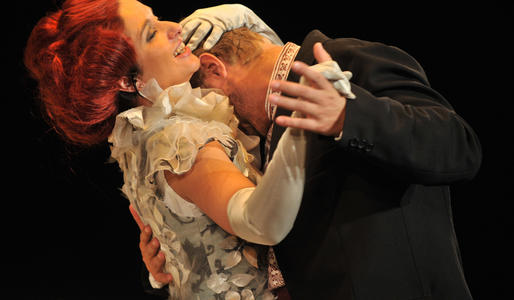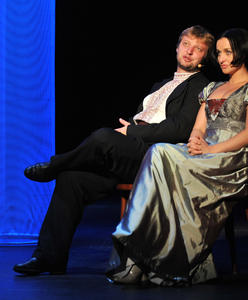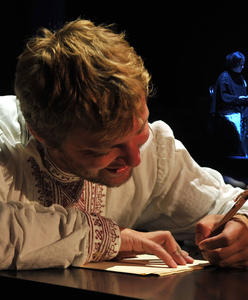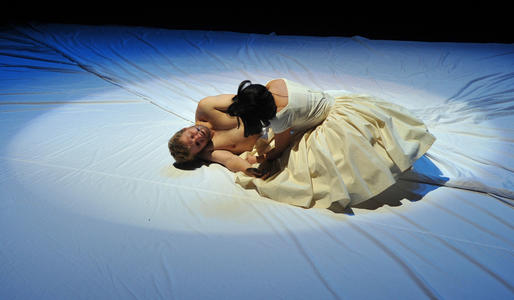Brno City Theatre: A golden fly and an Art Nouveau painter
Pavel Gajdoš 3. October 2011 zdroj České noviny
Brno City Theatre: A golden fly and an Art Nouveau painter
Brno City Theatre chose to kick off this theatre season with two ambitious premieres. The first was the story of school pupils immortalised in film, School, the Foundation of Life, while the second was Mucha’s Epopee, an attempt to map out the life of world-famous Czech painter Alfons Mucha in the period before he painted the famous and controversial Slavonic Epopee.
The first-mentioned production at Brno City Theatre was directed by tried-and-tested Hana Burešová, who has already put on a whole series of quality comedies such as The Stone Guest and The Importance of Being Earnest at the theatre. The involvement of Burešová in a production has long been a guarantee that it will not offer the shallow humour and smuttiness which unfortunately so often afflicts popularist theatres. Fortunately, the ‘guarantee’ has once again been honoured and so on Lidická St. one can see a tasteful performance, not pointlessly prolonged, and filled with well-loved phrases such as ‘Now I’ll explain in detail just how a poet becomes a dwarf’ and ‘What is happiness? Just a little golden fly!’
Few imagine that Martin Frič’s legendary film School, the Foundation of Life is not actually an original work. The script arose on the basis of a successful theatrical comedy, written on the request of E. F. Burian by secondary school teacher Jaroslav Žák. This in turn was a rewriting of the humorous prose work ‘Students and Teachers’ (Študáci a kantoři), which was very popular at that time. It was actually Žák’s theatre version that Burešová took as her main source. She then made good use of the multi-talented actors in bringing the work to life – they often grab musical instruments and, in the guise of a student band, knock out one popular period hit after another.
Burešová was particularly successful in her choice of actors to play the student characters. Petr Štěpán’s rebel, Benetka, is precisely as one would imagine, as is Milan Němec’s poseur/poet, Vojtěch Blahuta’s toadying Krhounek and Lenka Janíková’s timid schoolgirl, Marta Nováková. Both Ivana Vaňková as supply teacher Lachotová and Martin Havelka as chemistry teacher Cafourek played their positive roles with empathy. David Marek’s easily changed scenery also added to the performance.
In contrast with the previous work, Mucha’s Epopee is a new and original project by scenographer, choreographer and director Šimon Caban, who found fame as the creator of the "visual side" of the Karlovy Vary International Film Festival. In order to map out the parts of the Art Nouveau artist’s life at Brno City Theatre he joined forces with music composer Aleš Březina, the author of music for e.g. the films Knoflíkáři (Buttoners), Kráska v nesnázích (Beauty in Trouble) and Obsluhoval jsem anglického krále (I Served the King of England).
The production is concerned with the end of the 19th century, when Mucha was trying to find success in the art worlds of Paris and New York, though in the end his love for his Czech homeland won through. Various figures make an appearance: the enchanting but at the same time hysterical actress Sarah Bernhardt played with great accuracy by Markéta Sedláčková, the painter Luděk Marold (Jaroslav Matějka), and Marie Chytilová, the love of Mucha’s life, (again Sedláčková).
It is good that Caban did not let things slip into too much of a literal interpretation and didn’t copy Mucha’s colourful, decorative pictures in any way; he simply had the characters kind of pose in picture frames for a few seconds. The stage lifts at the Music Theatre were of great help in the speedy changes of scene necessitated by this production, and Aleš Březina’s music was very well done.
, , 3.10.2011
Master Mucha – our model!
Luboš Mareček 2. November 2010 zdroj Divadelní noviny
A new production by Brno City Theatre entitled Mucha’s Epopee presents skilful work with space, light as well as movement on the large stage. The author of these production elements is Šimon Caban. The title of this review wants to suggest the scent of national revivalism which governs the mood of the whole piece. Mucha’s Epopee is, as a result, somewhat bitterly ironic when it speaks, using the words of the painter himself, about the deep, stuffy Czech hollow which it will take a long time for the sun to reach. This three-hour-long stage colossus focuses on that which is genuine that has remained from Mucha’s life and heritage. It isn’t done via the overly-visible, likeable posters or the current domestic dispute which perhaps is foremost in the mind of today’s audience. The creators have admitted that they started their work on the project three years ago when the disputes between Moravský Krumlov and Prague weren’t yet topical.
The librettist, director and scenographer Šimon Caban and the music composer Aleš Březina haven’t created a biographical projection about our famous countryman from Ivančice, even though we linearly make our way through Mucha’s childhood up to the first decade of the last century. They have made some kind of epic of music and images about the life of a famous painter, rather than a speckled Art Nouveau folding picture book on the life of an international heavyweight personality, even though the production slips into descriptiveness and a slow pace at the end. Regarding the background to Mucha’s life the creators bring up e.g. the nationality question (a controversial topic in his time), proud nationalism but also exceptionally hard work in the service of an unusual talent and obsession for the world of beauty. Unfortunately, the producers didn’t make use of the great paradox of Mucha’s life; he was a great defender of Slavic emancipation and solidarity, but was born in the Austrian empire and died in the Protectorate of Bohemia and Moravia. However, they offered other perspectives.
Apart from the costume of Sarah Bernhard, whose Gismond on the poster ensured immortality both for the Master and the actress, you won’t experience any visual opulence in the costumes designed by Simona Rybáková. Modesty and allusion rules and everything is pleasantly simple, and mostly black and white. Mucha is in a simple Slavic shirt while others appear in simple but inventive costumes. The theatrical Mucha is supposed to be colourful, particularly as far as the inner meaning is concerned. Caban and Březina follow the painter from his youth in Ivančice throughout his difficult stage in Vienna, his academic studies in Munich, his phenomenal success in Paris and visit to America up until his return to his country, where he settled down at Zbiroh castle around 1920, already as an appreciated great figure, in order to paint for American money a famous series of works depicting Slavic history for the young Czechoslovak Republic…even though his nation didn’t care.
Caban and Březina have called their opus a ‘visually musical theatre experience’. Perhaps they wanted to advise that, even though it’s at the Music Theatre, you won’t be seeing a musical this time. Caban has created his own epopee in the form of swiftly alternating scenes up on the huge stage. Březina’s music helps him greatly in this; sometimes it creates the mood, sometimes it reminds one of a great symphony and also it inventively evokes the environments of Ivančice, Munich, Paris, New York and Prague. Březina’s musical blocks are the triumph of the production, which shows a certain mechanical inertia in the finale. It is, for example, the case of the pictures drawn by light through the fine canvasses in the large frames in which groups of actors always “freeze” completely in the spirit of Mucha’s somewhat affected poses. Fortunately, the director works inventively with shadow play and, as a former dancer, he can coordinate the on-stage movement with graceful choreography.
The producers were aware that Mucha’s life, which was filled with diligence and hard work, lacked any theatrically explosive peripeteia or personal tragedies. Perhaps that’s why the character of Vroubek appeared in the script, which is otherwise full of famous great figures such as Gauguin, Marold, Bernhardt, Loos and the donator C.R. Crane. This cunning and talentless provincial Czech is an embodiment of national vices. In the script, Vroubek is supposed to function as an imaginary personification of human and professional rottenness, as a counterpart to Mucha’s creative hard work, but also to express the injustice and disinterest which the painter received from his own nation. However, the character lacks fullness in places.
As far as the actors are concerned, the most attention goes to Michal Isteník in the main role as a good-hearted young man who relied too much on his kindness and joviality. This Mucha never insults anyone, and is an altruist till he drops. Isteník’s never-stopping smile becomes, however, counterproductive after some time. In fact, the performance is one-stringed and flat, as well as the script itself. More full-bodied characters are the quietly loyal wife Marie, acted by Markéta Sedláčková, or Marold, who died prematurely (presented as a pleasant Bohemian by Jaroslav Matějka).
The production captures one’s interest with its simple and yet technically demanding scenery as well as the gradual permeation of magnificent but not emptily showy scenes. The creators only overdid it somewhat with the adored Mucha’s human as well as artistic magnificence. The Master can of course definitely be an example for us, even though that might sound a bit old-fashioned to pragmatic contemporaries, and this is also why it was good that Mucha’s Epopee was “repainted” on the stage of Brno City Theatre.
Mucha’s Epopee doesn’t favour either Moravský Krumlov or Prague
Vladimír Čech 1. November 2010 zdroj Kam
The subtitle “visually musical experience”, as the director, scenographer, choreographer and librettist Šimon Caban and composer Aleš Březina have called their Mucha’s Epopee (premiere on Saturday, 18th September at the Music Theatre of Brno City Theatre), signals that this production is unclassifiable in terms of theatrical genre.
It isn’t a musical, which spectators would most probably expect. Březina’s score, which involves only live musicians, is audible perhaps throughout the whole production, though you won’t hear any singing from the actors. If we wanted to put Mucha’s Epopee into a ‘genre drawer’ at any cost, we would probably go for the one labelled ‘melodramas’.
Via all of his four job descriptions mentioned above, Caban gives a chronological insight into the peripeteia of the painter’s life in Mucha’s Epopee, with a large contribution from Březina. He doesn’t confabulate but sticks to historical facts. And thus we meet Mucha in Prague, Vienna, Munich, Paris, and also in New York in order to return humbly to our capital once again. Mucha is, of course, also accompanied by real historical characters such as his friend Luděk Marold, Sarah Bernhardt, Paul Gauguin and Marie Chytilová, who later become the artist’s wife. It can thus be said that for those who knew little or nothing at all about this native of Ivančice this performance is an easy way to gain knowledge in this field.
As the director and author, Caban didn’t incorporate the needed gradation to the almost documentary-like sequence of forty-three swift scenes this time, and thus the “experience” makes a lengthy impression. Not even Caban’s opulent artistic decoration, which is literally a feast for the eyes, can sufficiently cover up the weaknesses of the text.
Březina’s music is pleasant to listen to; the composer is very kind to the listeners’ ears and doesn’t irritate them with any dissonances. A suite made up from the best parts could, by the way, live an independent life a concert work. Understandably, Březina doesn’t dismiss the goal of illustration and so for example Mucha’s Munich stay is accompanied with majestic Wagnerian echoes while Paris comes with the sounds of chanson. Ondřej Tajovský is signed under the musical production, and he also directed the premiere. Even though Michal Isteník, with his elemental jovial expression and mainly his physical appearance, somewhat destroys one’s image of Mucha, his performance deserves recognition. From the many other characters, one will mainly remember the double role of Marie Chytilová and Sarah Bernhard played by Markéta Sedláčková, Jaroslav Matějka’s Marold and Stanislav Slovák as Gauguin.
The Slav Epopee itself doesn’t form a dominant part of the plot; it is spoken about at the very end, when “its turn comes”. The finale isn’t a glorification of Slavicness but rather a question mark over Czech smallness, and those who would perhaps expect a categorical judgement as to where the Slav Epic should find a definitive roof over its head will not hear it. Mucha’s dedication of the work to Prague is obviously included here; however, the conditions under which it should go there are also rightly stated.
Mucha’s Epopee is a theatrical report on a life-long dream
Karla Hofmannová 11. October 2010 zdroj www.zivotnistyl.cz
Brno City Theatre has presented a more than topical theatrical piece at its Music Theatre: Mucha’s Epopee – a work which maps the life of a famous artist who wasn’t wanted at home by anyone. And in fact, he still isn’t wanted.
The main element of the set is the huge canvasses behind which Mucha’s monumental work shines through as living images. It uses the imagination, i.e. there is a magical miniature train in which Mucha travels and a ship which transports letters between the artist and his beloved; and the image of the river Seine is also impressive. Key images from Mucha’s life or his idealistic thoughts are thematically arranged in quick succession. However, the play doesn’t go so smoothly here, becoming too educational and descriptive. The director compensates for the lack of dramatic tension on the stage by increasing the amount of decibels, which reach their maximum level very fast and become monotonous. Moreover, this loudness makes it hard to understand what the actors are saying, even though all of them use microports.
The role of Alfons Mucha is played by Michal Isteník, who personifies the ideal of a common, Moravian, idealistic, impractical and unselfish artist - he’s a kind and direct boy. He doesn’t change with the passing of time and he remains the same even at the end when he decides, as a mature man, to disappear into seclusion and create what he wants. The other characters are episodic; they pass through his life. The only ones that stand out a little more are Markéta Sedláčková as Sarah Bernhardt as well as his future wife Maria, and Lenka Bartolšicová as Mme Charlotte, the mother of artists. Vroubek, the only one who brings conflict into these relationships, is a character that was added by the author. A typical ‘little Czech’, whose small-minded provincialism is part of the essence of the Czech character, he is a painter yet a non-artist, and later a politician who is envious and does harm.
Mucha’s Epopee is a very topical piece, even though the current battles over his work aren’t spoken about here, and despite the fact that it deals with events which happened more than one hundred years ago. Highly professionally crafted, highly idealised and, in its end result, quite a sad work, because we come to realise that we haven’t changed much as a nation since that period.
Mucha’s canvasses came alive on the stage of the Music Theatre
Iveta Macková 1. October 2010 zdroj Kult
The operetta ensemble of Brno City Theatre presented the world premiere of an original project called Mucha’s Epopee, on the life and work of Alfons Mucha, in the second half of September at its Music Theatre. The librettist of this brand new project is Šimon Caban, who has returned to the stage of Brno City Theatre after his February debut production The Naked Muse.
This time, apart from being the director and the author of the set, he was also the librettist and choreographer. His production is dominated by an inventive and novel artistic component. The large white canvasses are “painted” by shining light through them onto the stylized images of live actors who are placed behind them. Projections are used for the completion or depiction of elements which aren’t present on the stage, and they also help to separate some scenes. The stylized simple and practical costumes are the work of Simona Rybáková and the author of the music is musical composer and musicologist Aleš Březina.
The plot of the production draws from the real life stories of the painter, designer and photographer Alfons Mucha (1860–1939), his friends and other people who appeared near him. The theatre story starts with Mucha’s decision to become a painter. His life story presents the Czech society of that time and its opinions which drove the talented young man far from his beloved country, though he never forgot it and always remained loyal. The plot pinpoints situations and relationships which haven’t changed, in fact, in the Czech Republic since the period when Mucha lived. That is – to know a certain craft doesn’t necessarily mean to be recognized and honoured; on the contrary – human skill was, and still is now, “deservedly” the target of animosity, while human incompetence is often successfully disguised by wire-pulling and the efforts of support staff and spin-doctors.
The title character is played by Michal Isteník, who was chosen due to his suitability in terms of the movement and visual stylization of the nearly three-hour-long production. Isteník’s Mucha doesn’t look like the famous painter at all, but with his humble acting expression, he is a dignified and pleasant personification of the “guide” though the memories of one of the most famous Czech artists and patriots.
Mucha’s Epopee: a colourful musical-visual fresco from the life of a famous painter
Kateřina Šebelová 29. September 2010 zdroj Velká Epocha
“Mucha’s Epopee is not a biographical melodrama as it could seem to be according to its title; it isn’t about the Slav Epic or its creation.”
The name of Alfons Mucha has been spoken quite frequently in the media as well as in public in the last few months. Despite that, the latest production at Brno City Theatre - Mucha’s Epopee - doesn’t aim to deal with this topic in any way, though it may seem otherwise at first sight. The script of the play Mucha’s Epopee, which premiered on 18th September 2010, was created long before the dispute about the Mucha’s famous cycle of paintings was kindled. The idea of immersing into Mucha’s internal world to somewhat reveal his character and the circumstances of his varied life was born in the head of scriptwriter and admirer of Mucha’s work Šimon Caban as much as three to five years ago. As the author said: “The theatre play isn’t about the Slav Epopee but about Mucha’s personal epopee.”
The Music Theatre without singingEven though the Epopee takes place at the Music Theatre, the spectators won’t hear any singing at any time during the performance. The creators of the play decided to leave singing out of it due to certain expressions used in old Czech. This suggestion seems to have been an exceptionally lucky one, as the audience can thus follow the musical and visual performance without being distracted by frilly old-fashioned singing which would sound comic and make this piece less serious.
The music wizard Aleš BřezinaThe music plays an irreplaceable role in this piece. It emphasizes emotions, increases drama, softly accompanies the individual moments of the painter’s life and also facilitates an insight into Mucha’s inner world. Here, director Caban made a great choice when selecting Aleš Březina to be the author of the music. Březina – the well known author of film and theatre music (Kawasaki’s Rose, Divided We Fall, Elegie zmizelého (Elegy of the Vanished) etc.) offers a colourful, impressive and captivating mix of music which is, undoubtedly, the strongest point of Mucha’s Epopee. This is also due to the excellent interpretation of the melodies by the orchestra of Brno City Theatre which, conducted by Ondřej Tajovský, presents enchanting and novel enjoyment for one’s ears. New as well as traditional musical pieces come to life here with unbelievable spontaneity, gentleness as well as urgency.
Mucha - a non-ageing workaholicMucha, acted by Michal Isteník, is depicted here as a sensitive and gifted artist but a somewhat impractical person who is constantly fighting with time and a lack of understanding from the side of the public. Isteník manages to depict Mucha’s patriotic heart and artistic talent. His perception of the world is full of emotion, love, Slavic feelings and endless battles with himself and his surroundings. Michal Isteník is mostly clothed in a plain white shirt with blossoms which characterizes his love for his country and Slavic culture. Even though Isteník managed to change the enthusiasm and emotions of the young Mucha, who moves about the artistic world of Paris, Munich, Vienna and New York, the workaholic Mucha doesn’t get any older – even though the years are passing, the actor remains the same both idea-wise and visually. The seriousness of the mature and ageing Mucha who is getting ready to paint his most significant work – the Slav Epopee – is also missing here.
As far as other acting performances are concerned, Mucha’s friend, the painter Marold played by Jaroslav Matějka, the affectionate Marie as well as strict Sarah Bernhard played by Markéta Sedláčková, or Hana Kováříková as the seducer, the femme fatale and Countess Rothschild all attract attention. The role of the profit-seeking Vroubek, who has a destructive influence on Mucha as well as on the opinion of Czechs about him, was acted by Tomáš Sagher. This role is unnecessarily dramatic and it makes an artificial and superfluous impression in this already drama-filled production.
The set – lively and colourfulLiving images – this is what Mucha’s creations on the theatre stage can be called. With the help of clever lighting, pictures appear on the canvasses at the painter’s gentle touch; there are living people standing behind the screens as if carved from stone. Richly dynamic scenes at balls, in the studio or pub, during various journeys or in the ‘parlour house’, accompany the spectators through the individual stages of Mucha’s life. The period costumes from Simona Rybáková’s workshop are excellent – they are diverse, elegant, simple, fine, exciting – exactly as is required in each situation.
Mucha’s Epopee is not a biographical melodrama as it might seem to be from the title; it isn’t even about the Slav Epopee and its creation. It is actually a performance which opens up the opportunity for a new genre. This ‘musically theatrical visual experience’, as it is subtitled by the authors, ensures that the spectators and their sensual perception are undoubtedly satisfied. Lovers of Alfons Mucha, of painting but also of good music and acting certainly won’t be disappointed. The unusual nature of this theatre performance makes it suitable also for students, as it can help them to understand Mucha as an artist as well as a person.
Caban’s production Mucha’s Epopee is pleasantly pathetic
Marie Reslová 28. September 2010 zdroj Kultura.iHNed.cz
Brno City Theatre has produced a “visual musical theatre experience,” Mucha’s Epopee. This is what the authors Šimon Caban (direction, scenography, libretto) and Aleš Březina (music) have called their work, which is truly comparable with Mucha’s Slav Epopee as far as monumentality is concerned.
Artist as workoholicIn reality, something like a large-format biographical documentary has been created on the stage of Brno City Theatre. Caban’s libretto is like a serious, somewhat overintellectualised documentary series – Mucha’s biography in pictures with fragmentary metaphorical overlaps. It lacks a dramatic axis as well as a clearly defined topic – unless that is the depiction of the Czech artist as a workaholic, innocent benefactor and keen patriot. Březina’s music is eclectic; we can hear quotations and replies from Czech music composers from Smetana to Martinů. It is heard throughout the three-hour-long production as a continuous musical background; it accompanies dynamic artistic scenes and adds atmosphere to spoken passages. It is interesting that the spoken word is somewhat non-musical here and that it corresponds with the music roughly at the level of a spoken commentary to a film which is dramatized by the musical accompaniment.
Czech Honza in ParisThe production of Mucha’s Epopee is somewhat oversaturated with information and interesting moments from the painter’s life. Mucha’s friendship with Gauguin (Stanislav Slovák), his strangely distant relationship with women and his close one with his friend Marold (Jaroslav Matějka), or the embodiment of an incapable, obtrusive and slanderous ‘provincial Czech’, a man called Vroubek (Tomáš Sagher), remain in one’s memory.
The purely visual scenes are really beautiful and inventive; the most impressive ones are the “child-like” ones, when the Ivančice countryside of Mucha’s childhood is covered by a snowy veil which then gradually “melts away”. Mucha’s artistic confrontation with Adolf Loos and modern abstraction in general is descriptive and artistically witty. One of the few buoyant episodes is the meeting of Mucha (Michal Isteník) with Sarah Bernhardt (Markéta Sedláčková) and the creation of a theatre poster for her performance.
The “experience” from Mucha’s Epopee isn’t unequivocal. The visual strong points alternate with banality (scenes from cafés or the Paris “artists hangout”), in a ratio of nearly 1:1. Both of the producers obviously have a personal feeling for Mucha which lends their work a pleasant pathos that doesn’t often appear on Czech stages. However, there is a thin borderline between celebrated patriotism and potential nationalism… Anyway, tribute needs to be paid to Brno City Theatre for its courage and its journey to discover new forms of Czech theatre.
Mucha’s Epopee – a somewhat different musical in which there is no singing
Peter Stoličný 21. September 2010 zdroj musical-opereta.cz
The fundamental approach of the authors to the piece was very wise. The work of Alfons Mucha is very well known. Ever since the great technical possibilities of printing were unleashed we have been able to see “Mucha” on mugs, postcards and calendars. Mucha is on coffee grinders and we can even find him as a decoration on potties or supplementary rear mirrors for lorries. Quite rightly, the artists (set by Šimon Caban, costumes by Simona Rybáková), didn’t copy a single Art Nouveau ornament for the set. Everything takes place against clear and often transparent white surfaces where we can see only living figures and groupings whose style is similar to those painted by Mucha. The librettist, scenographer and director in one managed to do magic with the transparent canvas and light; he sometimes veiled the stage in chiaroscuro and created an impressive atmosphere, “breathing” with the music.
The music deserves special attention. Aleš Březina is well known as the author of music for several successful Czech films. In Mucha’s Epopee he could probably express himself more clearly than in a film production. Creative freedom as well as discipline can be felt from his work (Freedom is the recognition of necessity – who said this? Spinoza…?) Březina isn’t afraid of using various genres, from sequences of great symphonic poems a la Tchaikovsky to wild rock from the 1980s via Viennese waltz, jazz and chanson. It is colourful and varied music joined together by the unifying handwriting of the composer. Sometimes it thunders in a great orchestral consonance, the next moment it sounds intimate, with a melody from a single musical instrument.
The librettist and director in one gave different amounts of space to his characters. Of course, the main hero, Alfons Mucha, is allocated the greatest quantity. Michal Isteník acts him keenly and with distinct energy. A little bit of expressivity suits him on the “big screen”. His friend Luděk Marold, acted by Jaroslav Matějka, is an excellent partner for him. The spontaneous love of life which the two show makes one envious. To live so beautifully and buoyantly…How beautiful that must be! Other characters enter and perform less dominantly in the story, with each of them acting their role in such a way that the two Czech painters remain in the foreground. The nicely written and acted characters of Gauguin, played by Stano Slovák, Mme Charlotte (Lenka Bartolšicová) and the publisher (Dušan Vitázek) should all perhaps be mentioned.
A dramatic character - a typical antihero - has been added to this story, which in its structure reminds one of a folding picture book (although this is in no way a problem). His name is Vroubek, and he is joyfully acted by Tomáš Sagher to create a really refreshing element in the otherwise jigsaw-like Epopee. Vroubek is an unsuccessful painter who weaves his way through Alfons Mucha’s life in order to finally become a successful Czech politician and, in his jealousy, a tireless enemy of the talented and successful Mucha. I have no idea who was the model for this character but I would say it was small-minded “Czech provincialism”.
Šimon Caban and Aleš Březina’s epopee will certainly become a successful production at Brno City Theatre, despite some of my reservations regarding the libretto. It isn’t an ordinary piece and it has set off on a difficult journey seeking a new or at least different form of expression for the musical-dramatic art. I’m keeping my fingers crossed for it.
Outside for the Czechs better than with them
Jiří P. Kříž 20. September 2010 zdroj Právo
Brno City Theatre came alive with the sounds of Alfons Mucha’s life
The great fresco that is Mucha’s Epopee is yet another great authorial work from Šimon Caban – direction, choreography, stage, libretto – at Brno City Theatre. Aleš Březina’s production raises it to the heights of a ‘visual musical theatrical experience’, as the official description goes. It probably isn’t necessary to introduce the author. Caban, known as one of the Prague Five, particularly from Baletní jednotka Křeč (The Convulsion Ballet Unit), is a versatile theatre producer. Březina became famous not only through his music for the films of Jan Hřebejk, but primarily due to the opera Zítra se bude… (Tomorrow There Will Be...) (libretto by Jiří Nekvasil) – for Soňa Červená in the role of Milada Horáková. Červená came with Vlastimil Harapes to the Brno premiere of Mucha’s Epopee and, alongside the other theatregoers, was witness to yet another of those musical spectaculars with which Brno City Theatre has long been surpassing everything that’s going on in this area in the Czech Republic.
In fact, the endless contradiction between the importance of the individual and the provincial Czechness of the majority is also fundamentally involved in the life of the world famous painter, who was the target of defamation at home. ‘I work for the Czechs better in Paris than when among them…,’ complained Mucha. ‘They make up for their lack of knowledge with arrogance and vainglory. That’s why it’s so foggy there…’ Doesn’t it remind you of something? Kundera, Salivarová, Škvorecký, Haas, Voskovec, Forman, Martinů, Kubelík… Successful Czechs don’t hang around here?!
Mucha’s Epopee follows Alfons step by step from his decision to become a painter, through Paris and New York and up to the time after his return to his native land, on the threshold of creating his masterwork – a cycle of huge canvases celebrating the history of the Slavs and their myths. It’s no coincidence that the Czechs are still arguing about the pictures even today, with Prague unable to fulfil Mucha’s will.
The strength of Mucha’s Epopee stems from the visual, choreographic and musical plan. Caban took only inspiration from the painter’s pictures and drawings, leaving space for his own grandiose composition, which is just an impression rather than a copy of the incomparable original. Within the great orchestral compositions of Březina’s music the sensitive ear will hear hints of the monumentalism of fading romanticism and impending impressionism, and also our past heritage, for example in the provocative drum solos.
Nationalism and cod nationalism
In the lobby during the break I heard about how Michal Isteník’s Alfons is just so un-Mucha-like. He’s no handsome specimen, unlike the original. But the same is true for him as it is for Caban’s stage: it’s no carbon copy. However, he is great at demonstrating the difference between nationalism and cod nationalism. Of the other figures in the story praise is deserved by Markéta Sedláčková in the roles of the love of Mucha’s life Maria Chytilová and bratty Sarah. Also praiseworthy - Stanislav Slovák as the boisterous impressionist Gauguin and Jaroslav Matějka as the painter Marold. Against their greatness stood the narrow-minded and insidious provincial Czech Vroubek as portrayed by Tomáš Sagher.
It’s an incredible entrance to a new theatre season. After the wide audience appeal of Hana Burešová’s School, the Foundation of Life, Caban and Březina’s work is an exclusive, musical-dramatic form – in the best nationalistic sense!
The stage Mucha’s Epopee is still relevant, but not due to the current dispute
Luboš Mareček 20. September 2010 zdroj MF Dnes
Brno City Theatre turned up with an interesting project at the weekend. The production Mucha’s Epopee takes a look at the renowned painter from a different perspective – and the titular series of paintings does not appear there.
The life and fate of this man of Ivančice and the uncompromising artistic and national stance of a genius who conquered the world is the focus of attention in this unusual musical production by librettist, director and scenographer Šimon Caban. The music to Mucha’s epopee was written by Aleš Březina, and in this almost three-hour performance there’s more than just a little music – it is almost omnipresent.
The producers have given Mucha’s Epopee the subtitle ‘A visual, musical and theatrical experience’. It is probably fruitless to speculate about the genre – but it will be useful to note that the Brno theatre hasn’t created a musical or an opera – there isn’t a single sung passage for the spectators. It’s not even a melodrama but rather it is a distinctive form of theatre in which the story is permeated with excellent music that is far from a simple accompaniment colouring the action up on stage. Březina’s successful music often fulfils a mood-creating function and at other times describes the surroundings, thus forming a strong element in this generally un-chatty performance. In places the musician Březina leads the spectator to Caban’s narrative and the result is a truly attractive musical-theatrical atmosphere.
A talented and hard working manCaban has tried to create a fresco featuring an exceptional man whose life was without love affairs, drastic problems and personal tragedies. This made it all the harder to put together dramatic material connected with this diligent, talented and hard working painter who was from the very beginning more devoted to the nationality question of the Czechs and the Slavic world than he was to the love of his life.
Drawing from Mucha’s biography, Caban depicts the artist’s pureness of character and benevolence, and his unselfish nature, which carries a reproach for the public which is far wider in scope. This production is not just about an Art Nouveau genius whose posters are known to all. The script describes moments of proud Czechness, the common struggle of his professional and personal life, his life-long devotion to the land of his birth, and his nation. What does it matter that today many of these themes sound very old fashioned and affected?
Honour and diligence in contrast with self-serving opportunism (Vroubek, Mucha’s fawning colleague, and later a successful politician) and the never-failing service to beauty are surely as timeless as the unremitting beauty of Mucha’s posters, canvasses and sketches.
There’s no drowning in ornamentationCaban puts the scenes in this well-peopled performance together very cleverly. Aside from the portrayal of famous actress Sarah Bernhardt he never lets Mucha’s ornamental style onto the stage so as not to drown out the central message. You won’t see a single pictorial reproduction, although there are many hints of those monumental works.
This good-hearted boy in his sewn Moravian shirt is known to the whole world from his fantastic decorations and curls, his Gismond poster, and his rings, brooches and necklaces which are still manufactured today. This world-wide success was the result not only of Mucha’s exceptional talent and diligence, but also his moral fibre, and in this the Master is perhaps even more radiant than his fascinating pictures and jewels - kudos to the producers.
Caban ends Mucha’s on-stage journey at Zbiroh Chateau in around the year 1910, when he had just begun to create the famous Slavonic Epopee, which Prague and Moravský Krumlov are now fighting over. This unnecessarily long and, after some time, slightly theatrically monotonous work doesn’t concern itself with this fact in any way. It’s good that Caban and Březina have remembered the famous Moravian in a completely different way to that in which he is portrayed in the media today.

